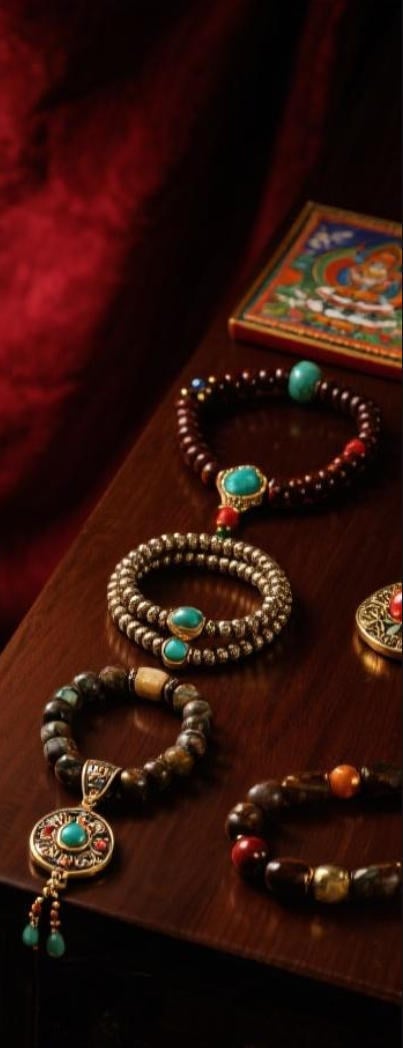
Amid the sophisticated tapestry among Tibetan spiritual traditions appear two valuable masterpieces: the painted thangka and the sacred bodhi bead. Every one, in its special manner, acts as a gateway for transcendental understanding. The thangka, a hand-painted tableau, delineates sacred characters, spiritual mandalas, or traditional chronicles, assisting meditative practice.
By comparison, the bodhi bead, often crafted from rare crystals, wood, grains, or ossein, is a tangible reminder of Buddha's liberation under the bodhi tree. Employing the beads assists in mental stillness.
- Jointly, the thangka and the bodhi bead represent the connection of beauty and piety. They offer a tangible link to the age-old knowledge of Tibetan Buddhism.
Chronicles Inscribed in Camel Ossicles
Over ancient epochs, historic treasures whisper tales concerning a world long forgotten. These are not luxurious objects of bygone empires, but straightforward camel bones engraved with characters that harbor the riddles of a bygone period. Every fragment whispers the echo from a life lived, a journey traveled, and a connection to the old wisdom that includes us all.
- These fragments
- Fragments
- Symbolize
Revealing the Hidden Language of Thangka Paintings
Tangkas are captivating paintings on canvas, meticulously crafted by Tibetan artists to depict divine figures and scenes from Buddhist philosophy. Each detail within a thangka is laden with importance, forming a complex tapestry of visual narratives that guide the viewer on a spiritual journey. The pigments used in thangkas are not merely aesthetic choices but carry powerful connotations, indicating different aspects of the Buddhist philosophy. From the stoic figures to the intricate ornamentation, thangkas offer a look into the rich world of Tibetan Buddhism, inviting us to ponder upon its enlightenment.
- Time-honored thangka art often depicts key Buddhist figures such as Buddha Shakyamuni, Bodhisattvas like Avalokiteshvara and Manjushri, and enlightened beings from various movements of Tibetan Buddhism.
- Through these representations lies a wealth of discernment that can be interpreted by those who examine the symbolic language of thangkas.
Bodhisattva's Path to Enlightenment: Embodied in Beads and Bone
Upon the winding journey to nirvana, the Buddha used symbols imbued with profound resonance. Entire bead and object held within them the essence of his transcendent vision, presenting glimpses into the mosaic of reality. Through their shape, the Buddha expressed profound realizations that exceed the realm of commonplace perception.
From such spiritual beads, crafted from special materials, radiated vibrations that synchronized with the evanescent powers within. The composition of a entity, meticulously transformed into tokens, served as tangible signals of the impermanence native to all manifestations.
Thangkas: Windows into Himalayan Spirituality
Thangkas radiant paintings on cloth serve as potent representations of Himalayan spirituality. These intricate works of art, meticulously created with delicate brushstrokes, depict a vast array of Buddhist deities, mandalas, and scenes from revered scriptures. Each thangka is an enlightening window for meditation and contemplation, offering perception into the intricate teachings of Buddhism.
- They are often used in ritual ceremonies to facilitate
- transcending states of spiritual transcendence.
- Thangkas operate as not merely decorative works but rather portals into the rich and intriguing world of Himalayan spiritual traditions.
Bodhi Beads: A Journey Through Mindfulness and Compassion
Each pellet on a bodhi bead mala whispers tales of ancient wisdom, guiding us on a pilgrimage through the tranquil waters of mindfulness. As we carry these intricately shaped beads, our fingers trace the contours of single one, anchoring our concentration in the present moment. The gentle substance of the beads against our palms serves as a tangible reminder to respire, fostering a sense of composure.
- At each bead that passes between our fingers, we encourage compassion, extending it first to ourselves and then outward to the world.
- Meditative schools teaches us that mindfulness is a skill that requires patience and perseverance.
With the aid of the rhythmic repetition of mantra or simply the mindful registering of the beads, we break free from the relentless chatter of the mind.
The practice involving bodhi beads is a soft invitation to reconnect our connection with ourselves and the world around us.
Focused Energy: Producing Camel Bone Bracelets for Higher Awareness
Focus represents a compelling drive in our lives, shaping our experiences and guiding us towards our sacred journey. When we combine this intention with the venerable truths of crafting a camel bone bracelet, we create a potent synergy that can enhance our spiritual growth.Camel bone embodies meaningful essence, representing stamina. Its natural beauty and ancient magnetism serve as a constant reminder of the elemental strength within each of us.By scrutinizing each piece, pour intentions into the design. With every knot or tie, we insert our hopes, dreams, and aspirations for spiritual evolution. This act of creation becomes a mindful activity, uniting us with our inner wisdom and guiding us on a road to insight.- Imbue each color element with specific spiritual meanings.
- Picture your goals interlaced in the bracelet’s form.
- Wear it as a constant reminder of your commitment to growth and transformation.
Unveiling the Significance of Camel Bones in Buddhist Traditions
In the rich tapestry embedded in Buddhist tradition, artifacts often hold profound symbolic meaning. Amid these varied objects, camel bone stands out as a noteworthy and fascinating element. Throughout history, this material has been incorporated in the crafting during various Buddhist instruments, each imbued with specific meanings.
- Recognized as a symbol of resilience and strength due to the camel's ability to overcome in harsh environments, camel bone often represents spiritual fortitude.
- Moreover, the color and texture concerning camel bone are believed with some to hold auspicious connotations, reflecting purity and serenity.
Hence, camel bone has become a esteemed part of Buddhist lineage, serving as a tangible nexus to the profound teachings of this ancient faith.
Thangka Canvases: Chronicles of the Sacred
Within the ethereal realm of Tibetan Buddhism, Thangka paintings emerge as sacred portals to enlightenment. These stunning works, meticulously crafted by skilled artists known as thangkapa, depict a myriad including vibrant deities, celestial beings, and mythical creatures. Each brushstroke saturates profound spiritual significance, narrating ancient tales and philosophical doctrines.
- Displaying a vast anthology of Buddhist iconography, Thangkas serve as both devotional objects and instructional tools. Reverent practitioners gaze upon these paintings during rituals and meditations, seeking to develop spiritual wisdom.
- Intricately adorned with intricate details embellished by diverse vibrant hues, Thangkas are considered windows into the divine. All painting acts as a symbolic representation of the Avatar's teachings and the path to liberation.
Via their effective imagery and symbolism, Thangka paintings offer a glimpse into the rich sacred traditions of Tibet. They are a testament to the enduring elegance of Tibetan art and its profound ability to illuminate.
Embracing the Duality: Thangkas and the Cycle of Life and Death
Thangkas, these colorful embroidered scrolls native to Tibet, provide an insightful exploration into the fleeting nature of life. Each intricate image depicts deities and beings engaged in the ongoing expedition of life and death, a symphony of birth, growth, impermanence, and regeneration. The artists skillfully interlace these concepts within the thangka's universe, highlighting the relation of all things. Through vivid motifs, they invite us to reflect on our own existence. The cycle revolves, a sequence of coming and going, spotlighting the preciousness of each moment. By embracing this duality, thangkas teach us to appreciate the bodhi beads bracelet beauty in both life's joys and sorrows.Chains of Spirituality: The Significance of Bracelets in Buddhist Practice
In the intricate tapestry of Buddhist practice, seemingly simple objects often hold profound meaning. Among these are bracelets, which serve as tangible representations of devotion and commitment to the doctrine of Buddha. Worn on the wrist, a bracelet behaves as a constant reminder of one's aspirations and dreams. It can symbolize the impermanence of life, inspiring practitioners to remain aware in the present moment. Some bracelets may include sacred glyphs, such as mantras or the names of Buddhas, which are perceived to bring forth positive energy and preservation. Others can be made from substances with spiritual significance, like sandalwood or lotus seeds, amplifying the bracelet's energy. Ultimately, the significance of a Buddhist bracelet rests far beyond its physical form. It becomes a powerful tool for prayer, a prompt to live in harmony with the teachings of Buddha, and a manifestation of one's unwavering devotion.